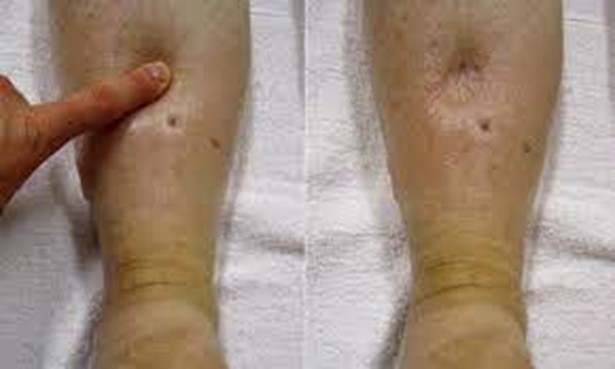A nurse is preparing to document information about a client's lower legs, which are swollen with 6 mm edema. Which of the following information should the nurse document?
1+ pitting edema.
2+ pitting edema.
3+ pitting edema.
4+ pitting edema.
The Correct Answer is C
The correct answer is Choice C: 3+ pitting edema.
Choice A rationale:
1+ pitting edema refers to mild pitting edema. It is characterized by a slight indentation that disappears rapidly. A measurement of 6 mm edema is beyond the scope of 1+ pitting edema.
Choice B rationale:
2+ pitting edema indicates moderate pitting edema. It is characterized by a deeper indentation that takes a few seconds to rebound. While 6 mm edema might be associated with 2+ pitting edema, it is not the most accurate description.
Choice C rationale:
3+ pitting edema signifies moderately severe pitting edema. It is characterized by a noticeable indentation that remains for a short duration. A measurement of 6 mm edema aligns with 3+ pitting edema, making it the correct choice.

Choice D rationale:
4+ pitting edema represents severe pitting edema. It is characterized by a deep indentation that persists for a significant amount of time. 6 mm edema is not typically associated with 4+ pitting edema.
Nursing Test Bank
Naxlex Comprehensive Predictor Exams
Related Questions
Correct Answer is A
Explanation
The correct answer is choice A. Ego integrity vs. despair.
Choice A rationale:
Erikson's Theory of Psychosocial Development outlines various stages of development that individuals go through across their lifespan. In the final stage, which occurs in late adulthood, individuals either experience a sense of ego integrity or despair. Ego integrity is characterized by a sense of fulfillment and satisfaction with one's life choices, while despair is marked by feelings of regret and a sense of unfulfillment. The older adult client expressing that their life has no purpose suggests a struggle with finding meaning and satisfaction, aligning with the ego integrity vs. despair stage.
Choice B rationale:
Generativity vs. self-absorption is a stage that occurs during middle adulthood. It involves concerns about contributing to society and the next generation. This stage is not applicable to the scenario described with an older adult who is grappling with a lack of purpose in life.
Choice C rationale:
Identity vs. role confusion is a stage that occurs during adolescence, where individuals explore their sense of self and develop their identities. This stage is not relevant to the older adult client's situation of feeling purposeless.
Choice D rationale:
Intimacy vs. isolation is a stage that typically occurs during young adulthood, where individuals seek close and meaningful relationships with others. This stage is not appropriate for the older adult's feelings of lacking purpose.
Correct Answer is B
Explanation
The correct answer is choice B: "Support the client's feet with foot boots."
Choice A rationale:
Flexing the client's feet using pillows might not be sufficient to prevent foot drop. Foot drop is a condition where the client is unable to dorsiflex their foot, and using pillows alone may not provide adequate support to prevent this condition.
Choice B rationale:
Supporting the client's feet with foot boots is the most appropriate intervention to prevent foot drop due to immobility. Foot boots are specifically designed to hold the foot in a dorsiflexed position, preventing the calf muscles from tightening and causing foot drop.
Choice C rationale:
Placing a hand roll under the client's heels might offer some relief, but it's not the most effective intervention for preventing foot drop. Hand rolls are generally used to prevent footdrop by keeping the ankles in a neutral position, rather than solely supporting the heels.
Choice D rationale:
Removing ankle-foot orthotic devices at bedtime is not recommended if the client is at risk for developing foot drop. Ankle-foot orthotic devices are designed to provide continuous support to the feet and prevent muscle contractures. Removing them at bedtime could compromise the effectiveness of the intervention.
Whether you are a student looking to ace your exams or a practicing nurse seeking to enhance your expertise , our nursing education contents will empower you with the confidence and competence to make a difference in the lives of patients and become a respected leader in the healthcare field.
Visit Naxlex, invest in your future and unlock endless possibilities with our unparalleled nursing education contents today
Report Wrong Answer on the Current Question
Do you disagree with the answer? If yes, what is your expected answer? Explain.
Kindly be descriptive with the issue you are facing.
